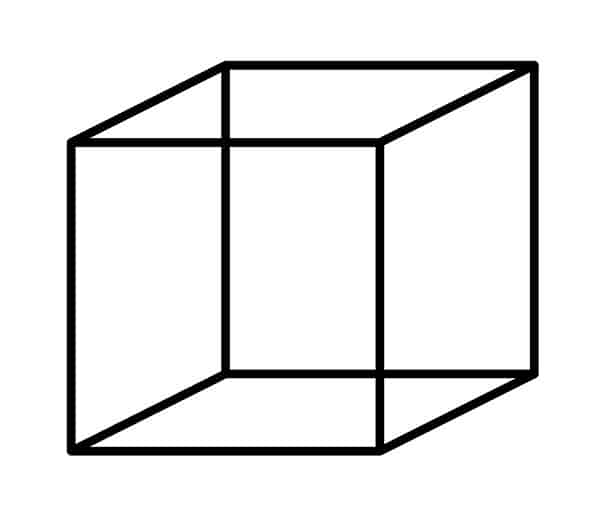Hugh D Reynolds reviews The Case Against Reality: How Evolution Hid the Truth from Our Eyes by Donald D Hoffman

Remember that old optical illusion of a 3D cube drawn in 2D? While viewing this “Necker cube”, what I think is the frontmost face suddenly flips and becomes the back of the block. At any given moment while I am looking at it, I can tell which of two alternative sides – the lower-left or the upper-right square – is at the “front” of the cube. Yet when I’m not looking, I have no idea which of the two faces, if any, is really there.
Donald D Hoffman, cognitive psychologist from the University of California, Irvine, likes to perform this same trick with tomatoes. As he suggests in his latest book, The Case Against Reality: How Evolution Hid the Truth from Our Eyes, that juicy red fruit on your plate ceases to be when you don’t look at it. And he doesn’t stop at tomatoes. For Hoffman every single thing, from a neuron to the Sun, is a mere “icon” upon our mental desktop: a user interface geared to aid survival in a world utterly and inscrutably different from anything we could conceive it to be. The way we perceive a Necker cube turns out not to be some freakish anomaly, but a key to recognizing that our perceptions are non-veridical – that is, they didn’t evolve to see the truth.
Our perceptions are non-veridical. They didn’t evolve to see the truth
Smell, hearing, touch and taste are no less deceptive than sight. The dismal advice is that if I reach out to grasp my tomato, it is not something “out there” to be eaten – instead, this tactile experience is just manipulation of another kind of icon. Depth itself is in Hoffman’s firing line too, as are all dimensions of space–time, and the physical bodies many of us inhabit. These are mere holographic inflations, akin to a video game.
Inevitably, the film The Matrix is a running reference throughout the book, and Hoffman clearly prides himself on being a “red pill” drugs baron. The sophistication of the book comes in showing how we can take a simulation seriously, without taking it literally. One of the most insightful chapters tells how marketing executives exploit our fallible perceptions, pushing hyper-perceptual products such as Lee Jeans’ Body Optix technology. This uses optical physics and laser printing to create a pair of trousers that perfectly highlights the contours of your body. Even as the very fabric of reality is being torn into tatters by Hoffman, he’s sure that consumerist fashions will continue to flourish.
A key tenet of the book is that truth itself can be hazardous to life. According to Hoffman, on seeing a long-winding object in the grass, it’s best to react as if it’s a poisonous snake. The small cost of a mistake, in cases where it turns out to be a hosepipe, is outweighed by the gain to overall fitness in remaining unbitten. Hoffman has an array of examples like this, which align with the “Fitness-Beats-Truth” (FBT) theorem. Under FBT, perception strategies that enhance fitness always “win-out” over strategies that try to accurately depict an objective reality.

These examples build a sturdy pillar of support for perceptual infidelity. It’s on climbing a second pillar – a parallel case against reality built up from physics – where things get shakier. Read as a primer on the foundations of physics, these chapters are rewarding. Where I began to struggle was in understanding how that physics marries up with Hoffman’s work in cognitive science. It feels like Hoffman is pushing an analogy into an unjustified sameness.
Take symmetry. There are abundant symmetries in our perceptions. Just look again at that tomato. For Hoffman, these symmetries “reveal how we compress and encode information, not the nature of objective reality”. He seeks common cause with John Wheeler and his famous phrase “It from bit”. The view is that it is our observation of, and interaction with the universe, that makes stuff exist. Information processes, rather than particles and space–time structures, are fundamental. While the audacity of such theories is recognized throughout the book, opposing positions aren’t.
It is exhilarating territory to explore, and Hoffman is an amiable guide. He gives wonderfully clear accounts of key features in that terrain, such as the “Kochen-Specker Theorem” (that no property has a definite value that is independent of how we measure it). He puts these to work undermining any worldview that pretends to see a world divorced from its context of observation.
Is that to say that there are no symmetries “out there” in the world? Not quite. The absence of a clearer link between research into perception (we don’t perceive the world as it is) and research in the foundations and philosophy of physics (there may not be a world “out there” to perceive) left me longing for a more substantial bridge between these pillars.
Hoffman wants it both ways: drawing heavily on physics to undermine perceived reality, he rejects physicalism – the view that, at root, everything is physical. In its place he posits a radical proposal: consciousness itself is fundamental, something that “just is”, rather than something that needs explaining in terms of other things. This is a cunning move, but it fails to respect the peculiarity of platforms on which cognitive processes are performed.
Reflecting on this rollercoaster read, I’m grateful to Hoffman for showing that “We have mistaken the limits of our interface for an insight into reality.” Grateful while still reeling from his suggestion that conscious agents are “just math[s]”.
- 2019 Allen Lane 272pp £20hb



